NorthEast Radio Watch 12/8/2025: Cichon’s Back in Buffalo
In this week’s issue… Veteran newsman returns - Remembering NY's Leitner, RI's Jones - CT AM saved - Maine AM moves - "Indie" adds suburban signals
Text and photos by SCOTT FYBUSH
It was a rainy morning when we headed out for our second day of seeing Louisville, Kentucky’s broadcast sites last August – but the weather never stops us when there’s radio to be seen.
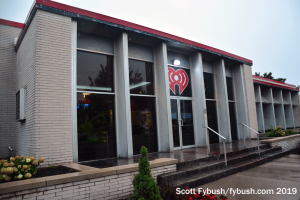
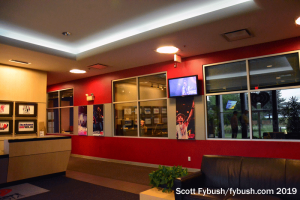
And there’s lots of radio to be seen on Radio Drive, even though that “street” is really just the entrance to a parking lot in an industrial area off I-264 out in the suburbs southeast of Louisville.
Since 1998, this sprawling building has been home to what’s now the iHeart cluster of stations, which consolidated here back in the Jacor/Clear Channel era from several locations around town.
Stand in the lobby (once you’ve dried out from a run through the downpour) and the stations you’ll see through the studio windows are two of the oldest and biggest in town: straight ahead, news-talk WHAS (840) and to the right, its longtime sister station, country WAMZ (97.5).
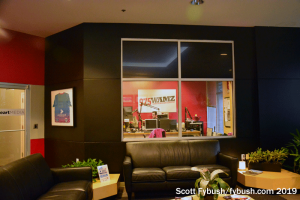
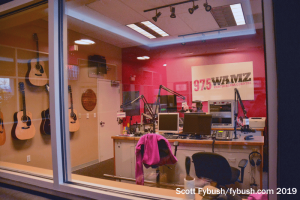
These were the old Louisville Courier-Journal stations, the pride and joy of the Bingham family, and they moved here from the building off Sixth Street downtown where they’d been located since the 1960s along with their former TV sister, WHAS-TV (Channel 11).
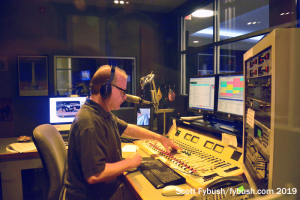
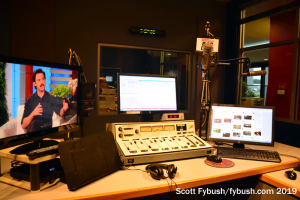
WHAS is still live and local for much of the day, broadcasting from this row of showcase studios that includes a talk studio, a control room and a news studio. It’s one of three AMs in the cluster: WKRD (790) is the sports station, taking its calls and identity from the University of Louisville Cardinals; WKJK (1080) is the overflow outlet for national syndicated talk and the Kentucky Sports Radio network, which focuses on the rival University of Kentucky. Their studios are located around the corner from the row of WHAS studios, and they’re both in use when we stop by, so we don’t get very good looks at them.
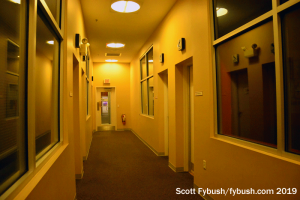
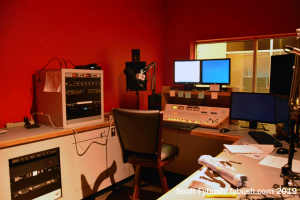
Turn right from the lobby and you’re in the realm of the FM stations in the cluster, all arrayed along one long hallway: WTFX (93.1) is urban “Real 93.1,” WQMF (95.7) is the classic rocker, WNRW (98.9) was top-40 “Radio Now” and WLGX (100.5) was hot AC as “Kiss.” (A few months after our visit, WLGX rebranded with variety hits as “100.5 FM,” taking the most excellent new calls WSDF in honor of your editor’s initials, or perhaps just for Louisville’s airport code; WNRW then became “Kiss,” still with top-40.)
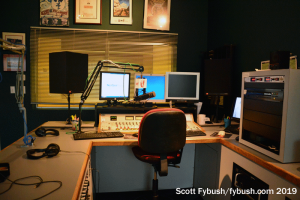
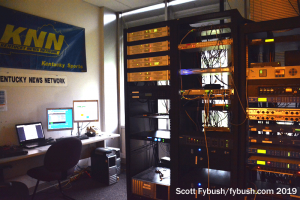
Behind and beyond the studios, there’s lots of office space in this building, which was once a showroom and training center for the nearby General Electric Appliance Park; there are still ramps in back where the new models of refrigerators and electric ranges were once wheeled up to an auditorium stage.
Today, the Kentucky News Network operates its statewide service from one side office, with lots of room for sales offices, the WHAS newsroom, engineering offices, and a pretty neat lounge area, too.
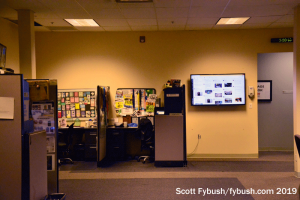
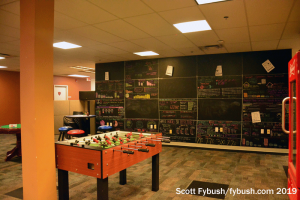
Truth be told, though, this studio tour was just a prelude to an even more exciting part of the morning: an opportunity to check off a big AM transmitter site from our life list – and another historically significant site on the way out there.
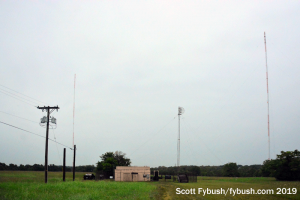
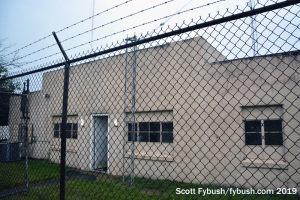
The station on 790 that’s now doing sports as WKRD was known to generations of Louisville listeners as top-40 WAKY, and its 5000-watt signal came from this four-tower site in Jeffersontown, nine miles or so east of where the iHeart studios now sit.
Before Gordon McLendon made it WAKY, 790 was WGRC, and it started out on 1370 from a site in New Albany, Indiana, moving to 1400 and a Louisville site before making the 1951 move to 790 out here in “J-Town.”
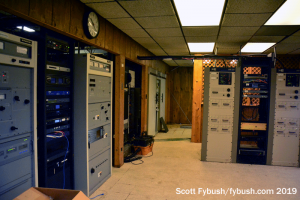
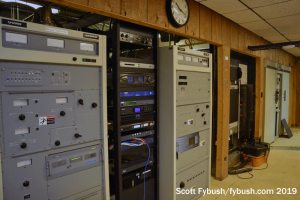
Where the original WGRC/WAKY transmitters once sat at the center of the transmitter building, there’s now a newer FM facility: on 98.9, WNRW’s 43kW class C2 facility was a Louisville move-in in two steps, having started out as the FM side of WSLM up in Salem, Indiana, then relocating into the Louisville market in the 1990s from a site on the Indiana site before arriving here in 2010, changing its city of license to Prospect, Kentucky and using a directional antenna on the southeast 790 tower.
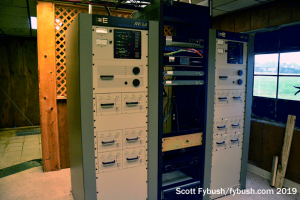
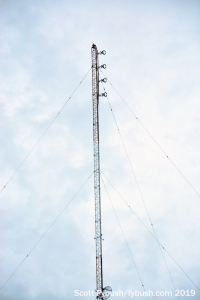
(Before that, the 100.5 signal, now WSDF, had also moved here to the 790 site; it’s in a separate building out by the southwest tower, using its own four-bay ERI on that stick.)
We didn’t get a chance on this trip to cross over to the Indiana side to see all the iHeart sites over there, including the WKJK 1080 site. That will have to wait for a future trip – and we look forward to doing it, because just as WKRD is the former top-40 giant that was WAKY, the WKJK 1080 facility was once the big top-40 competitor, WKLO.
What we did get to see to wrap up this Louisville visit was even more exciting and historic, though: join us again in this space next week for a look at the big gun of Louisville radio, the mighty WHAS.
Thanks to Michael Golchert and Chris Myers of iHeart Louisville for the tours!

As we announced a few weeks ago, the 2026 edition of the Tower Site Calendar will be the last.
We began publishing it 25 years ago, and the broadcast landscape is radically different now.
Radio World just ran an excellent article about us if you want to know more.
Once it’s gone, that’s it. We won’t be printing any more.
Thank you to everyone who saw our announcement and rushed to buy it. We appreciate you.
(There are some calendars from previous years if you want more of a tower photo fix — all under $5.)
But don’t wait to get this year’s Tower Site Calendar — buy it now!
We are selling the Broadcast Historian’s Calendar again this year, but we have that in an even smaller quantity — definitely don’t hesitate for that.
And visit the Fybush Media Store to check out our selection of books and videos, too!
And don’t miss a big batch of Louisville IDs next Wednesday, over at our sister site, TopHour.com!
Next week: WHAS, Louisville
In this week’s issue… Veteran newsman returns - Remembering NY's Leitner, RI's Jones - CT AM saved - Maine AM moves - "Indie" adds suburban signals
In this week’s issue… Scripps stations face takeover - Sinclair moves more affiliations - CT stations sold - Maine AM surrendered - Remembering WVBR's Shapiro, WABC's Morgan
In this week’s issue… CT TV legend succumbs to cancer - Remembering PA's Adams - FCC still stalled by shutdown - Pittsburgh morning host exits
In this week’s issue… FCC faces reopening challenges - Veteran Boston anchor retires - Morning shift in Toronto - NYC FMs expand reach